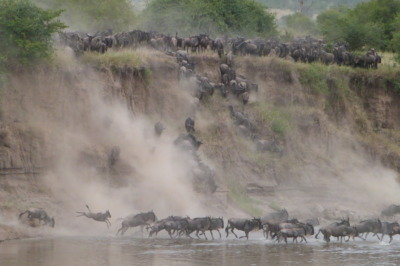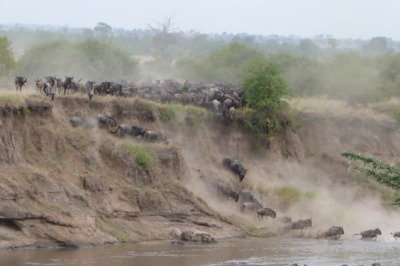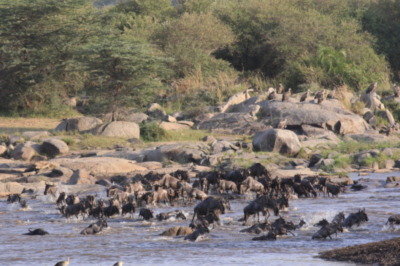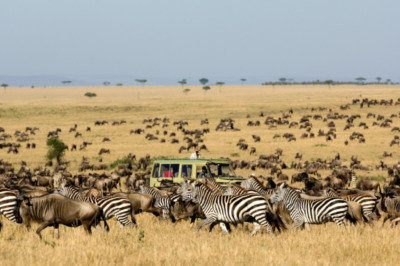The Great Wildebeest Migration is one of the greatest natural events to take place on earth. This annual event sees millions of wildebeest, plus zebra and gazelles, move annually in an endless cycle across Tanzania’s Serengeti and Kenya’s Mara, in search of better grass.
Renowned Tanzanian photographer, Ainslie Wilson, has captured one of the ‘shots of the season’ with this incredible image of the Wildebeest crossing the crocodile infested Mara River.
 Ainslie Wilson's ‘Shot of the Season’
Ainslie Wilson's ‘Shot of the Season’The migration is an iconic safari option for many adventure travellers each year. Carel Verhoef, Great Wildebeest Migration Expert from Discover Africa, has just returned from the Mara River and witnessed some wonderful river crossings. Below he gives expert tips on what happens and how best to experience the event - for any travellers thinking of heading out to Africa to witness the “Greatest show on earth”.
 Photo Credit: Ainslie Wilson
Photo Credit: Ainslie Wilson1. You need to get to the Mara River at the right time
It is important that you speak to the right people when planning your “River Crossing Safari” – not many travel companies have the knowledge to get you there at the right time. The new HerdTracker app is a great way to check on where the herd is, it gives you regular updates on this in real-time, and this will give you a good indication when you should be traveling, in order to see the herd crossing.
2. Buy yourself as much time as you can on the river itself
The Mara River both on the Serengeti side and Masai Mara side has plenty of resident game and big cats, which gives you the opportunity to view general game including lion, leopard, elephant, buffalo and cheetahs along with its incredible natural beauty. If you are serious about seeing river crossings, buy as many nights as you can, and as close to the river as possible.
 Photo Credit: Carel Verhoef
Photo Credit: Carel Verhoef3. Wait for the energy to build up
The higher the Mara River water level, the more difficult it is to cross, and the more intimidating the jump, which means that the wildebeest and zebra need enough energy to build up before they take the plunge. Wait a few days for the numbers to build up on the river - it helps if there are wildebeest on both sides. You will immediately know when the time is right, as you will hear the wildebeest calls becoming louder and more frequent.
4. Position yourself away from the river and observe
Don’t sit too close to the river bank, this might block the herds without you knowing. Position yourself away from it, so that you can allow the herds to move right to the water’s edge. Look for dust as the crossing starts and then move closer. Once the crossing has started it will not stop because of the energy it creates, so you can get within a few hundred meters of the action.
5. Both sides of the river
Ensure that you give yourself the best possible chance by going to both the Serengeti and the Masai Mara. During August visit the Serengeti first and then the Masai Mara and September and October the Mara first and then the Serengeti. This significantly increases your chances, and the international border will not stop you from seeing the herds cross.
 Photo Credit: Carel Verhoef
Photo Credit: Carel Verhoef6. Try and see more than one crossing and move up and downstream
If there are good numbers arriving on the river then it is easy to get stuck waiting for one herd to cross. Make sure you have a look up and down the river from where you are waiting, for other possible crossings taking place. You generally need to be alert to all the build-up on the river banks.
Tip – Don’t just take pictures, it is an incredible experience and part of this is being able to soak it all up. When you do take pictures, make sure you don’t over zoom, you need the wider angle to capture the magnitude of what is happening!
For more information, visit: www.discoverafrica.com

